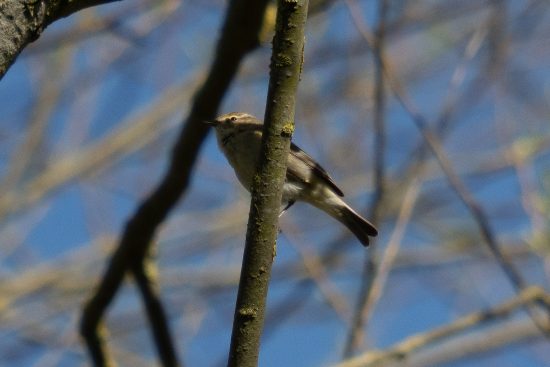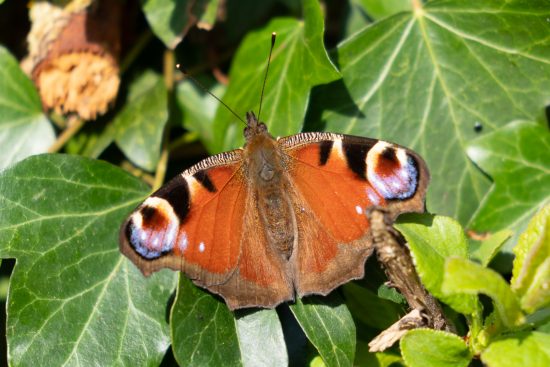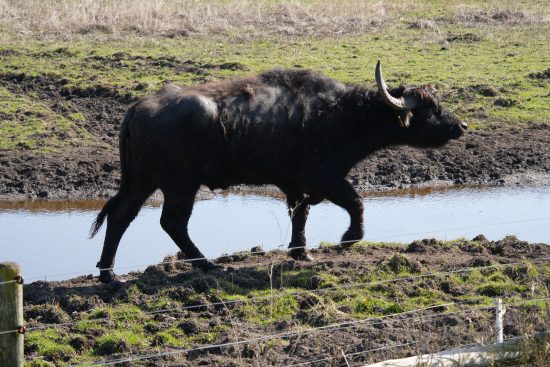I went to find warblers, and I did. This is a chiffchaff, doing its best to hide as they usually do. I won't tell you how many photos I deleted to get this one. which is pretty much in focus at maximum zoom, and then cropped somewhat:

They are incredibly noisy for their diminutive size. Their call is 'chiff-chaff' - hence the name. The eyestripe is very distinctive.
It was also time for early butterflies. This is a peacock, enjoying the morning apricity (as was I):

And, for one reader of this blog from Florida, I am pleased to say East Anglia's resident water buffalo are doing just fine:

And that's a new watering hole for them, built this winter at Kingfisher Bridge, just south of Ely.
Thanks for reading this post.
You can share this post on social media of your choice by clicking these icons:
There are links to this blog's glossary in the above post that explain technical terms used in it. Follow them for more explanations.
You can subscribe to this blog's daily email here.
And if you would like to support this blog you can, here:


 Buy me a coffee!
Buy me a coffee!

“I went to fund warbles, and I did.”
Good for you!
Oops…..
Very rewarding Richard – my own peramblings across and along the brooks of North Middlesex cant compete – a jigsaw of suburb and rurality, towards Barnet but did get what looked like a little egret and and also a very rattly woodpecker echoing along the brook.
There may have been warblers – but I’m a hopeless watcher.
A little egret and a woodpecker. That’s not bad! And for me, the most interesting bird, is always the one in front of me, from a wood pigeon onwards.
Glad you found a chiffchaff. I found 3 singing male blackcaps on Tooting Common yesterday. None today,so birds on passage and looking at the charts there’s ideal conditions for a big arrival in the coming week. I find a spot of birdwatching incredible therapeutic after a spot of bad news watching.
No black cap here yet – but they must be coming this way.
Thanks
Dear Richard
What is your view on the the introduction of a land tax? Could it be helpful in curbing land banking and increasing the number of new homes built. Could it be useful in promoting better land management to reduce flooding risk and increasing biodiversity?
I asked Chat GPT to summarise my own work on this:
Richard Murphy, a professor of accounting practice at Sheffield University Management School and director of Tax Research UK, has expressed skepticism regarding the implementation of Land Value Taxation (LVT). In his August 2024 article titled “Land value taxation is not a panacea,” Murphy outlines several concerns:  
• Valuation Challenges: Murphy argues that LVT relies on assessing the rental value of land separate from any structures upon it—a process he deems complex and prone to disputes. He emphasizes that most property owners are unfamiliar with distinguishing between the value of their land and the value of the buildings on it, leading to potential confusion and appeals. 
• Revenue Generation Doubts: He questions the feasibility of replacing existing taxes with LVT, suggesting that the revenue generated from taxing land alone might be insufficient to meet governmental financial needs. 
• Economic Impact on Tenants: Murphy challenges the notion that LVT would solely affect landowners, asserting that landlords would likely pass on the tax burden to tenants through increased rents, thereby impacting those who may already be financially vulnerable.
Instead of implementing LVT, Murphy advocates for alternative approaches to address economic disparities and generate public revenue: 
• Taxing Rental Income: He proposes increasing taxes on rental income, such as introducing an investment income surcharge, to more effectively capture revenue from property ownership without the complexities associated with LVT. 
• Capital Gains Tax Adjustments: Murphy suggests raising capital gains tax on the sale of land to ensure that profits from land sales contribute fairly to public finances. 
• Development Land Tax: He recommends reintroducing a development land tax to capture the increase in land value when planning permissions are granted, thereby ensuring that the community benefits from land development activities. 
Murphy concludes that while the concept of LVT may appear theoretically sound, its practical implementation poses significant challenges. He emphasizes the need for pragmatic tax solutions that are understandable to the public and effective in addressing economic issues. 
For a more comprehensive understanding of Murphy’s perspective, you can read his full article here:
https://youtu.be/BzAIpya15H0?si=vZSxxTwHIlLNXgGB
Additionally, Murphy discusses these views in a video titled “Land value taxation is not the panacea that its proponents claim,” which you can watch below: 
That is one good looking water buffalo!
Just for you
Looks up the word ‘apricity’!
Ah! Every day is a school day. A lovely new word to use, thanks!
Apricity is a good feeling
Especially in spring
Thank you for “apricity”!
A word I like
I’m currently reading ‘Bicycling with Butterflies’ by Sara Dykman, who followed the migration of the Monarch butterfly from Mexico to the Canadian border and back again. by bicycle. It’s beautifully told but also alarming. The Monarchs rely on milkweed for food and to lay their eggs, however the prairie, where the milkweed once grew in abundance is virtually gone due to crop planting, mostly corn (which she says is used for cattle feed and to produce ethanol for motor fuel). In addition, unregulated crop spraying and now pest resistant GM modified crops are all contributing to the demise of the milkweed and thus the Monarch butterflies. It’s a microcosm of the consequences of the extractive approach to our relationship with the planet. A poignant tale she tells is that during WW2 the floss from milkweed was gathered by thousands of school children in the USA for use in life jackets for servicemen. The milkweed is now being repaid by being exterminated and with it, the Monarchs.
In differing ways, a story being seen many times the world over.
Barbara Kingsolver’s ‘ Flight Behaviour’ is where I learnt about the Monarch butterfly and the perils it faces.
Did you know that we have our own massive butterfly migration with the Painted Lady flying from Moroccan desert to Sweden and Middle East to Baltic. In 2019 I witnessed a major eruption/passage in SW Turkey with painted ladies flying horizon to horizon for days in untold number. Hundreds in a minute passed in a 5m gap I measured out. They moved for days. But what food would they find when they reached Northern European intensively managed agricultural landscapes?